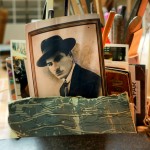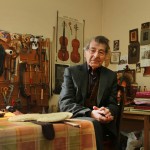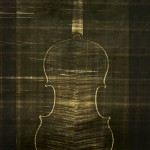Martin Erician
Martin Yeritsyan: The oldest luthier in Armenia
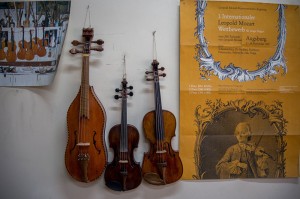 In the small courtyard of the American Orphanage in Greece, barefoot children, dressed in uniforms, eagerly await a miracle. His sad and deep eyes, witnesses of unspeakable horrors, shine for the first time.
In the small courtyard of the American Orphanage in Greece, barefoot children, dressed in uniforms, eagerly await a miracle. His sad and deep eyes, witnesses of unspeakable horrors, shine for the first time.
Shahen has promised to play with them. The beautiful melodies, coming from the sad strings of the violin, transport the orphans to their lost families and their distant homeland.
The children’s melancholy thinking is shattered when someone suddenly shouts from the building, “Who’s playing that music?” A minute later, he appears in the principal’s office. “It was me sir, I was playing the violin.” The angry eyes of the director look at him. “You just survived the massacres and now you’re having fun? Give me that violin,” he demands.
Then comes the sound of wood breaking. Shahen sees the broken pieces of his violin scattered on the ground. It would be a turning point in his life.
After the incident with the conductor, Shahen Yeritsyan, a young man from Western Armenia, a survivor of the Armenian Genocide, carefully repairs his instrument. Later, he would grow up, find Greek masters, learn the secrets of the craft, and become a luthier. He would move to Soviet Armenia in 1925 and later be remembered as the founder of the violin-making school in Armenia.
- “My father played a crucial role in the lives of many famous musicians; he provided them with wonderful instruments and eased their long road to success,” says Martin.
- “I have children and a grandson who will carry on this tradition and the knowledge we have from my father. This is a family thing and needs to be passed down from generation to generation. The same practice exists in Italy, with the sons of Stradivari who continued his art… In fact, I have my secrets”, Yeritsyan explains.
- “For me, a good instrument requires the right kind of wood and a delicious sound. The sound is what attracts people. I prefer an instrument that is not beautiful but with an impressive sound than a beautiful instrument with a poor sound”, she details.
Today, in a small room in the basement of the Aram Khatchaturian House-Museum in Yerevan, Shahen’s son, Martin Yeritsyan, 85, proudly continues his father’s vocation. “In 1925, my father established the first violin-making school in Armenia with the help of Ieghishé Charentz,” says Martin. “It was the first studio in Soviet Armenia to make violins, mandolins, guitars, cellos, and various musical instruments.”
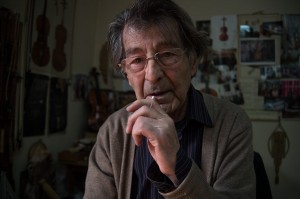 Thanks to Shahen Yeritsyan’s efforts, today Armenia has an advanced violin-making school. Her son acknowledges that her father’s journey from an orphanage in Greece to becoming one of Armenia’s greatest luthiers was fraught with heartache and loss.
Thanks to Shahen Yeritsyan’s efforts, today Armenia has an advanced violin-making school. Her son acknowledges that her father’s journey from an orphanage in Greece to becoming one of Armenia’s greatest luthiers was fraught with heartache and loss.
“My father Shahén and his brother Masís were survivors of the Trabizonda genocide. After they managed to escape the massacres in western Armenia, they lived and worked with the Kurds for a while until they finally arrived at the American Orphanage in Athens,” explains Martín.
It was while Shahen was in the orphanage that he managed to buy a violin from an Armenian woman to play music and entertain the children. Several years later he moved to Soviet Armenia, but his brother Masís traveled to France to continue his education.
After years of separation, Shahen finally convinced his brother to move to Armenia as well. “In 1932, after many guarantees from my father, Masís also came to Armenia,” says Martin. “He was a noble man and a wonderful violinist who knew several languages.” However, during the political repressions in the Soviet Union, his uncle, Masis, was arrested along with many other intellectuals, including Ieghishé Charentz, and was deported to Siberia. Shahen never heard from him again.
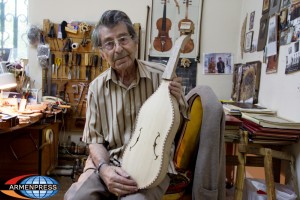 Since childhood, Martin Yeritsyan watched his father make instruments. In a career that spanned 67 years, Martin produced more than six hundred. “My father played a crucial role in the lives of many famous musicians; he provided them with wonderful instruments and eased their long road to success,” says Martin, who recalls that he made his first violin with the help of his father when he was a 23-year-old student at Yerevan’s Gomidás State Conservatory. .
Since childhood, Martin Yeritsyan watched his father make instruments. In a career that spanned 67 years, Martin produced more than six hundred. “My father played a crucial role in the lives of many famous musicians; he provided them with wonderful instruments and eased their long road to success,” says Martin, who recalls that he made his first violin with the help of his father when he was a 23-year-old student at Yerevan’s Gomidás State Conservatory. .
“I became a violin maker thanks to the knowledge and experience I received from my father. I also traveled a lot and it was a great opportunity to get acquainted with other European luthiers, explore their instruments and learn from them”, he explains.
As he works on a new violin in his workshop, he explains that the time it takes to make an instrument depends on the master, not the item. The teacher is the one who needs to know every detail of it.
“Wood is the most important material. I use it made of spruce, from the forests of the Caucasus, since the structure and appearance are quite similar to those used by classic Italian luthiers. It is crucial for the sound of the violin: the spruce makes a clear sound”, he details. “Each individual violin I made using this wood had a magnificent sound, a unique timbre. But the craftsmanship and skill of the person who performs it is fundamental”.
Martin Yeritsyan almost always performs several instruments at the same time. “When I start making violins, it’s three, five or seven at a time, always with odd numbers. I only work on a specific instrument when there is a special request. And I always test my instruments. My friend, the famous violinist Jean Ter-Merguerian, also tried my instruments. If it is of decent quality then I can offer it. I never offer it to anyone until it’s perfect.”
The teacher’s first critic is the teacher himself
Before the collapse of the USSR, Yeritsyan used to make instruments for the Moscow State Commission for Musical Instruments and for the Astrakhan Conservatory. According to him he says, during the state exams for this institution, the jury members were always surprised by the wonderful sound of his violins.
“I am proud that people like my instruments. I am a continuator of my father’s school. Thank God, my two sons, one in Spain and the other in Armenia, are also violin makers,” he says.
Professor Yeritsyan’s instruments today are valued at approximately four or five thousand dollars and he has orders from all over the world, although he clarifies that it is the age of the instrument that determines its value.
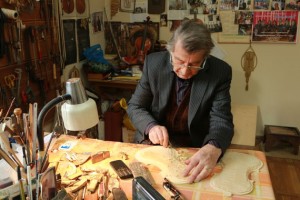 “My father’s are much more expensive now than when he was alive, similar to what happens with Stradivari, who sold his instruments for three gold coins, but now they are valued at millions of dollars. The time must pass for people to look for my instruments”, he says.
“My father’s are much more expensive now than when he was alive, similar to what happens with Stradivari, who sold his instruments for three gold coins, but now they are valued at millions of dollars. The time must pass for people to look for my instruments”, he says.
The Armenian luthier not only knows the exact number of instruments he has made during his life, but also remembers every detail of each one of them. “I have several notebooks where I record all the characteristics of each instrument. I look at the type of wood, its origin, the future owner of the instrument, the details about the soundboard [the top and bottom surfaces of the violin]. Taking into account all the information in my notebooks, I made about 300 violins, between 100 and 150 violas, 39 cellos and other instruments”, he comments.
Yeritsyan has also created a unique model of an Armenian national instrument. Grigor Arakelian, a musician who currently plays it, suggested calling it the Armenian viola. It is slightly larger than a viola, but smaller than a cello and has a unique structure and timbre.
“Once at a concert, one of the musicians was playing an Armenian melody with the kemancha. It was not pleasing to my ear, as the sound of kemancha cannot reveal a true Armenian melody,” he says. This inspired him to create his own national viola: “I decided to create a new type of Armenian instrument, so that people would play it instead of kemancha and we could hear the impressive and pleasant sound of Armenian melodies.”
As he also comments, the sound of the instrument is what attracts people. “I prefer an instrument that 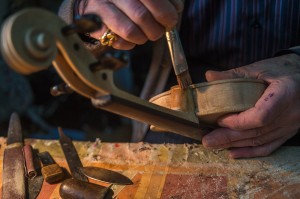 is not beautiful but has an impressive sound than a beautiful instrument with a poor sound. The audience sitting 8 or 10 meters from the stage will prefer to hear the sound than to look at the instrument”, she explains. The master luthier ensures that if an instrument is made correctly, it will eventually sound better and better. “Time has an impact on the timbre and sound of instruments.”
is not beautiful but has an impressive sound than a beautiful instrument with a poor sound. The audience sitting 8 or 10 meters from the stage will prefer to hear the sound than to look at the instrument”, she explains. The master luthier ensures that if an instrument is made correctly, it will eventually sound better and better. “Time has an impact on the timbre and sound of instruments.”
Many people want to learn the art of violin making, but Yeritsyan will not share family secrets with others: “I have children and a grandson who will carry on this tradition and the knowledge we have from my father. This is a family thing, and it should be passed down from generation to generation. The same practice exists in Italy, with the sons of Stradivari who continued his art… In fact, I have my secrets”.
In this sense, he affirms, for example, that when he refused to reveal the type of varnish he uses for his violins to an Italian master, he was not offended because the man understood the tradition. “I told him it’s a family secret. My kids are the only ones who know about it,” he says.
Yeritsyan labels each instrument using the old European tradition. The label language is Latin: “I write ‘Martin Yeritsyan, son of Shahen, Yerevan and the year.’ You can read the label on the ‘F’ on the violin.”
The mysterious and mystical sounds of the violin, made by the hands of a master luthier, trained by a father who experienced loss and calamity but embarked on a journey of beauty and creation, can be seen, heard and felt in this small room in the basement of the House-Museum of Aram Khatchaturian in the capital of modern Armenia. A room full of different types of wood, various tools and musical instruments in various stages of construction. While his senses are affected by the smell of wood and glue, the wrinkled hands of Martin Yeritsyan, the oldest violin maker in Armenia, continue to carve and scrape the top of a violin.
As he sits at the table working, Martin looks up and says, “I don’t have an honorary degree, but I believe my instruments are the greatest contribution to my nation.”
Arpine Haroyan/evnreport.com
artin Yeritsyan: The oldest luthier in Armenia
 In the small courtyard of the American Orphanage in Greece, barefoot children, dressed in uniforms, eagerly await a miracle. His sad and deep eyes, witnesses of unspeakable horrors, shine for the first time.
In the small courtyard of the American Orphanage in Greece, barefoot children, dressed in uniforms, eagerly await a miracle. His sad and deep eyes, witnesses of unspeakable horrors, shine for the first time.
Shahen has promised to play with them. The beautiful melodies, coming from the sad strings of the violin, transport the orphans to their lost families and their distant homeland.
The children’s melancholy thinking is shattered when someone suddenly shouts from the building, “Who’s playing that music?” A minute later, he appears in the principal’s office. “It was me sir, I was playing the violin.” The angry eyes of the director look at him. “You just survived the massacres and now you’re having fun? Give me that violin,” he demands.
Then comes the sound of wood breaking. Shahen sees the broken pieces of his violin scattered on the ground. It would be a turning point in his life.
After the incident with the conductor, Shahen Yeritsyan, a young man from Western Armenia, a survivor of the Armenian Genocide, carefully repairs his instrument. Later, he would grow up, find Greek masters, learn the secrets of the craft, and become a luthier. He would move to Soviet Armenia in 1925 and later be remembered as the founder of the violin-making school in Armenia.
- “My father played a crucial role in the lives of many famous musicians; he provided them with wonderful instruments and eased their long road to success,” says Martin.
- “I have children and a grandson who will carry on this tradition and the knowledge we have from my father. This is a family thing and needs to be passed down from generation to generation. The same practice exists in Italy, with the sons of Stradivari who continued his art… In fact, I have my secrets”, Yeritsyan explains.
- “For me, a good instrument requires the right kind of wood and a delicious sound. The sound is what attracts people. I prefer an instrument that is not beautiful but with an impressive sound than a beautiful instrument with a poor sound”, she details.
Today, in a small room in the basement of the Aram Khatchaturian House-Museum in Yerevan, Shahen’s son, Martin Yeritsyan, 85, proudly continues his father’s vocation. “In 1925, my father established the first violin-making school in Armenia with the help of Ieghishé Charentz,” says Martin. “It was the first studio in Soviet Armenia to make violins, mandolins, guitars, cellos, and various musical instruments.”
 Thanks to Shahen Yeritsyan’s efforts, today Armenia has an advanced violin-making school. Her son acknowledges that her father’s journey from an orphanage in Greece to becoming one of Armenia’s greatest luthiers was fraught with heartache and loss.
Thanks to Shahen Yeritsyan’s efforts, today Armenia has an advanced violin-making school. Her son acknowledges that her father’s journey from an orphanage in Greece to becoming one of Armenia’s greatest luthiers was fraught with heartache and loss.
“My father Shahén and his brother Masís were survivors of the Trabizonda genocide. After they managed to escape the massacres in western Armenia, they lived and worked with the Kurds for a while until they finally arrived at the American Orphanage in Athens,” explains Martín.
It was while Shahen was in the orphanage that he managed to buy a violin from an Armenian woman to play music and entertain the children. Several years later he moved to Soviet Armenia, but his brother Masís traveled to France to continue his education.
After years of separation, Shahen finally convinced his brother to move to Armenia as well. “In 1932, after many guarantees from my father, Masís also came to Armenia,” says Martin. “He was a noble man and a wonderful violinist who knew several languages.” However, during the political repressions in the Soviet Union, his uncle, Masis, was arrested along with many other intellectuals, including Ieghishé Charentz, and was deported to Siberia. Shahen never heard from him again.
 Since childhood, Martin Yeritsyan watched his father make instruments. In a career that spanned 67 years, Martin produced more than six hundred. “My father played a crucial role in the lives of many famous musicians; he provided them with wonderful instruments and eased their long road to success,” says Martin, who recalls that he made his first violin with the help of his father when he was a 23-year-old student at Yerevan’s Gomidás State Conservatory. .
Since childhood, Martin Yeritsyan watched his father make instruments. In a career that spanned 67 years, Martin produced more than six hundred. “My father played a crucial role in the lives of many famous musicians; he provided them with wonderful instruments and eased their long road to success,” says Martin, who recalls that he made his first violin with the help of his father when he was a 23-year-old student at Yerevan’s Gomidás State Conservatory. .
“I became a violin maker thanks to the knowledge and experience I received from my father. I also traveled a lot and it was a great opportunity to get acquainted with other European luthiers, explore their instruments and learn from them”, he explains.
As he works on a new violin in his workshop, he explains that the time it takes to make an instrument depends on the master, not the item. The teacher is the one who needs to know every detail of it.
“Wood is the most important material. I use it made of spruce, from the forests of the Caucasus, since the structure and appearance are quite similar to those used by classic Italian luthiers. It is crucial for the sound of the violin: the spruce makes a clear sound”, he details. “Each individual violin I made using this wood had a magnificent sound, a unique timbre. But the craftsmanship and skill of the person who performs it is fundamental”.
Martin Yeritsyan almost always performs several instruments at the same time. “When I start making violins, it’s three, five or seven at a time, always with odd numbers. I only work on a specific instrument when there is a special request. And I always test my instruments. My friend, the famous violinist Jean Ter-Merguerian, also tried my instruments. If it is of decent quality then I can offer it. I never offer it to anyone until it’s perfect.”
The teacher’s first critic is the teacher himself
Before the collapse of the USSR, Yeritsyan used to make instruments for the Moscow State Commission for Musical Instruments and for the Astrakhan Conservatory. According to him he says, during the state exams for this institution, the jury members were always surprised by the wonderful sound of his violins.
“I am proud that people like my instruments. I am a continuator of my father’s school. Thank God, my two sons, one in Spain and the other in Armenia, are also violin makers,” he says.
Professor Yeritsyan’s instruments today are valued at approximately four or five thousand dollars and he has orders from all over the world, although he clarifies that it is the age of the instrument that determines its value.
 “My father’s are much more expensive now than when he was alive, similar to what happens with Stradivari, who sold his instruments for three gold coins, but now they are valued at millions of dollars. The time must pass for people to look for my instruments”, he says.
“My father’s are much more expensive now than when he was alive, similar to what happens with Stradivari, who sold his instruments for three gold coins, but now they are valued at millions of dollars. The time must pass for people to look for my instruments”, he says.
The Armenian luthier not only knows the exact number of instruments he has made during his life, but also remembers every detail of each one of them. “I have several notebooks where I record all the characteristics of each instrument. I look at the type of wood, its origin, the future owner of the instrument, the details about the soundboard [the top and bottom surfaces of the violin]. Taking into account all the information in my notebooks, I made about 300 violins, between 100 and 150 violas, 39 cellos and other instruments”, he comments.
Yeritsyan has also created a unique model of an Armenian national instrument. Grigor Arakelian, a musician who currently plays it, suggested calling it the Armenian viola. It is slightly larger than a viola, but smaller than a cello and has a unique structure and timbre.
“Once at a concert, one of the musicians was playing an Armenian melody with the kemancha. It was not pleasing to my ear, as the sound of kemancha cannot reveal a true Armenian melody,” he says. This inspired him to create his own national viola: “I decided to create a new type of Armenian instrument, so that people would play it instead of kemancha and we could hear the impressive and pleasant sound of Armenian melodies.”
As he also comments, the sound of the instrument is what attracts people. “I prefer an instrument that  is not beautiful but has an impressive sound than a beautiful instrument with a poor sound. The audience sitting 8 or 10 meters from the stage will prefer to hear the sound than to look at the instrument”, she explains. The master luthier ensures that if an instrument is made correctly, it will eventually sound better and better. “Time has an impact on the timbre and sound of instruments.”
is not beautiful but has an impressive sound than a beautiful instrument with a poor sound. The audience sitting 8 or 10 meters from the stage will prefer to hear the sound than to look at the instrument”, she explains. The master luthier ensures that if an instrument is made correctly, it will eventually sound better and better. “Time has an impact on the timbre and sound of instruments.”
Many people want to learn the art of violin making, but Yeritsyan will not share family secrets with others: “I have children and a grandson who will carry on this tradition and the knowledge we have from my father. This is a family thing, and it should be passed down from generation to generation. The same practice exists in Italy, with the sons of Stradivari who continued his art… In fact, I have my secrets”.
In this sense, he affirms, for example, that when he refused to reveal the type of varnish he uses for his violins to an Italian master, he was not offended because the man understood the tradition. “I told him it’s a family secret. My kids are the only ones who know about it,” he says.
Yeritsyan labels each instrument using the old European tradition. The label language is Latin: “I write ‘Martin Yeritsyan, son of Shahen, Yerevan and the year.’ You can read the label on the ‘F’ on the violin.”
The mysterious and mystical sounds of the violin, made by the hands of a master luthier, trained by a father who experienced loss and calamity but embarked on a journey of beauty and creation, can be seen, heard and felt in this small room in the basement of the House-Museum of Aram Khatchaturian in the capital of modern Armenia. A room full of different types of wood, various tools and musical instruments in various stages of construction. While his senses are affected by the smell of wood and glue, the wrinkled hands of Martin Yeritsyan, the oldest violin maker in Armenia, continue to carve and scrape the top of a violin.
As he sits at the table working, Martin looks up and says, “I don’t have an honorary degree, but I believe my instruments are the greatest contribution to my nation.”
Arpine Haroyan/evnreport.com

